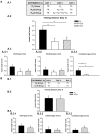Repeated labilization-reconsolidation processes strengthen declarative memory in humans
- PMID: 21850268
- PMCID: PMC3151295
- DOI: 10.1371/journal.pone.0023305
Repeated labilization-reconsolidation processes strengthen declarative memory in humans
Abstract
The idea that memories are immutable after consolidation has been challenged. Several reports have shown that after the presentation of a specific reminder, reactivated old memories become labile and again susceptible to amnesic agents. Such vulnerability diminishes with the progress of time and implies a re-stabilization phase, usually referred to as reconsolidation. To date, the main findings describe the mechanisms associated with the labilization-reconsolidation process, but little is known about its functionality from a biological standpoint. Indeed, two functions have been proposed. One suggests that destabilization of the original memory after the reminder allows the integration of new information into the background of the original memory (memory updating), and the other suggests that the labilization-reconsolidation process strengthens the original memory (memory strengthening). We have previously reported the reconsolidation of human declarative memories, demonstrating memory updating in the framework of reconsolidation. Here we deal with the strengthening function attributed to the reconsolidation process. We triggered labilization-reconsolidation processes successively by repeated presentations of the proper reminder. Participants learned an association between five cue-syllables and their respective response-syllables. Twenty-four hours later, the paired-associate verbal memory was labilized by exposing the subjects to one, two or four reminders. The List-memory was evaluated on Day 3 showing that the memory was improved when at least a second reminder was presented in the time window of the first labilization-reconsolidation process prompted by the earlier reminder. However, the improvement effect was revealed on Day 3, only when at least two reminders were presented on Day 2 and not as a consequence of only retrieval. Therefore, we propose central concepts for the reconsolidation process, emphasizing its biological role and the parametrical constrains for this function to be operative.
Conflict of interest statement
Figures





Similar articles
-
The role and dynamic of strengthening in the reconsolidation process in a human declarative memory: what decides the fate of recent and older memories?PLoS One. 2013 Apr 26;8(4):e61688. doi: 10.1371/journal.pone.0061688. Print 2013. PLoS One. 2013. PMID: 23658614 Free PMC article.
-
Strengthening a consolidated memory: the key role of the reconsolidation process.J Physiol Paris. 2014 Sep-Dec;108(4-6):323-33. doi: 10.1016/j.jphysparis.2014.09.001. Epub 2014 Sep 16. J Physiol Paris. 2014. PMID: 25218188 Review.
-
Retrieval under stress decreases the long-term expression of a human declarative memory via reconsolidation.Neurobiol Learn Mem. 2017 Jul;142(Pt A):135-145. doi: 10.1016/j.nlm.2017.03.005. Epub 2017 Mar 8. Neurobiol Learn Mem. 2017. PMID: 28285131
-
Reconsolidation in humans opens up declarative memory to the entrance of new information.Neurobiol Learn Mem. 2010 Jan;93(1):77-84. doi: 10.1016/j.nlm.2009.08.006. Epub 2009 Aug 22. Neurobiol Learn Mem. 2010. PMID: 19703575
-
The fate of memory: Reconsolidation and the case of Prediction Error.Neurosci Biobehav Rev. 2016 Sep;68:423-441. doi: 10.1016/j.neubiorev.2016.06.004. Epub 2016 Jun 7. Neurosci Biobehav Rev. 2016. PMID: 27287939 Review.
Cited by
-
Memory reconsolidation as a tool to endure encoding deficits in elderly.PLoS One. 2020 Aug 7;15(8):e0237361. doi: 10.1371/journal.pone.0237361. eCollection 2020. PLoS One. 2020. PMID: 32764815 Free PMC article.
-
Modulation of memory reconsolidation by adjacent novel tasks: timing defines the nature of change.Commun Biol. 2023 Dec 19;6(1):1288. doi: 10.1038/s42003-023-05666-5. Commun Biol. 2023. PMID: 38114781 Free PMC article.
-
The lateral neocortex is critical for contextual fear memory reconsolidation.Sci Rep. 2019 Aug 21;9(1):12157. doi: 10.1038/s41598-019-48340-9. Sci Rep. 2019. PMID: 31434945 Free PMC article.
-
Odor cueing during sleep improves consolidation of a history lesson in a school setting.Sci Rep. 2022 Jun 20;12(1):10350. doi: 10.1038/s41598-022-14588-x. Sci Rep. 2022. PMID: 35725905 Free PMC article.
-
Addiction: a drug-induced disorder of memory reconsolidation.Curr Opin Neurobiol. 2013 Aug;23(4):573-80. doi: 10.1016/j.conb.2013.01.022. Epub 2013 Feb 14. Curr Opin Neurobiol. 2013. PMID: 23415831 Free PMC article.
References
-
- Barlett F. Mc Millan; 1932. Remembering: A study in Experimental and social Psychology.
-
- Schacter DL, Norman KA, Koutstaal W. The cognitive neuroscience of constructive memory. Annu Rev Psychol. 1998;149:289–318. - PubMed
-
- Brown R, Kulik J. Flashbulb memories. Cognition. 1977;5:73–79.
-
- Loftus EF, Miller DG, Burns HJ. Semantic integration of verbal information into a visual memory. J Exp Psychol Hum Learn Mem. 1978;4:19–31. - PubMed
-
- Müller G E, Pilzecker A. Experimentelle beitrage zur lerhe Vom gedachtnis. Z Psychol. . 1900;(Suppl.1)
Publication types
MeSH terms
LinkOut - more resources
Full Text Sources
Medical

